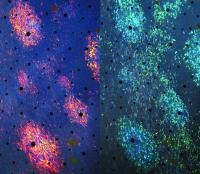A team led by Roger Hanlon at the Marine Biological Laboratory (MBL) has received $6 million from the Office of Naval Research to research on and simulate the capability of selected marine creatures to change color and merge into the background.
Hanlon, who has been researching on the camouflage techniques of squid, octopus, and cuttlefish, is working with a team comprising materials scientists and nanotechnologists at Rice University in an endeavor to create materials that could simulate cephalopod concealment. Naomi Halas, a Rice University scientist in nano-optics and the chief researcher, says the four year program will enable them to create materials that are alert and can respond to and change with their environment.
 MBL's Squid iridophore splotches viewed at normal (red) and oblique (blue angles
MBL's Squid iridophore splotches viewed at normal (red) and oblique (blue angles
In 2008, a team led by Hanlon at MBL found that cephalopod skin has opsins, a light-sensing protein similar to those in the eyes. This program will help them study distributed light detection across the skin. The manner, in which the nervous system makes use of that visual data, could lead to the discovery of new neural circuitry.
The MBL team will work with cephalopods to analyze how opsin molecules react to light and enable the animal's optical system to modify skin patterns to communicate danger and merge into the background. Multiple methods will be utilized. The MBL team, which also consists of scientists, Mäthger and Alan Kuzurian, will work with marine biologist Thomas Cronin, University of Maryland, Baltimore County.
The research will concentrate on simulating cephalopod skin with new metamaterials that work the same way with both material and machine.